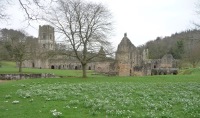York reflections
May. 1st, 2017 09:43 pmAnd I'm back! Well, truth be told I've been back for a while, but life - both at work and off work - has been quite busy and evenings have just gone too quickly. TL;DR version: It was great! Fully recommended.
Longer version:
The MSc courses (plural, as they also gave me the schedule for the general Masters skill module, which turned out be be in turns useful and not applicable) were all on Mondays: mornings and afternoons. The first week I used the time in between to randomly walk the centre of York, to get my bearings. As York still has most of its medieval street network, it took a little while, even considering that I have a good sense of directions. And it's a really lovely town. Reminds me of both Oxford, Cambridge and Lund.
Housing wise I was very lucky, and could stay with a friend's friend's friend not very far from the city centre. Such a luxury to be able to walk to work! Otherwise housing might have been a bit difficult. Most ads I saw online had a minimum of six month's stay, which doesn't work if you're only there for a single term (i.e. ten weeks).
The Ancient Biomolecules course covered most things (DNA, isotopes, proteins, lipids), and thankfully with the assumption that most of us were coming at it from a humanities background rather than science, so they started with a quick basic recap. With only one class per week, it was a lot of reading. They put up the powerpoints on the university intranet so you could go back and check, but as someone who hadn't taken either biology nor chemistry since the age of sixteen, I could have done with a somewhat slower pace. There were also two essays, one not graded - probably so that anyone who didn't get what the teachers were at post-grad level after could be set straight, rather than magnificently fail on that second essay with counted for 100% of the marks for the course. We could choose our own topics for the second essay (with approval from the course teacher), which I thought was really nice. So much better to pick a topic that you are really interested in, rather than being forced to learn something that you either find very difficult or find totally uninteresting. So I played to my strengths and chose to write about zooarchaeology and biomolecular methods. It all went well until I checked my word count* and realised that I had to do some serious editing in order to fit in that last section. And that was something that the examiner picked up as well. Still, can't complain, I got 69! So so close to the magical 70, which turn the grade into "distinction". (For readers elsewhere: The UK university grading system technically runs from 0-100, but where most students will land at 50-70. If you get over 80 you could probably get your essay published with few edits.
*: Luckily the bibliography wasn't included in the word count (although title and chapter headings were), as mine ran for 6.5 pages!
The Masters' Skills module was everything a Masters student would need in order to write their dissertation. Of course, covering _all_ archaeology Masters students, there were sections which were irrelevant to some, and excluded sections that other students would have needed. But I had some good use of Maximizing your MS Word skills (taught by a professional editor who deals with MS Word manuscripts all day long) and discussions on reference databases like Endnote. Less useful classes for me were Using archives, Image depositories (of course if I would do something on British archaeology, they would probably be very useful). The data management and statistics could be an entire module on its own (and apparently previously they had done that one in two classes rather than in one).
Some days I took the bus to the main campus (Archaeology is in Kings Manor in the city centre (Kings Manor being appropriately 16th century; however the archaeology building is 1970s concrete...)) and the BioArCh labs to get some hands-on experience of protein analysis of parchment. It was very fun, and I wish I had had more time for this. The campus itself is quite a labyrinth of paths between various colleges, departments and student housing (almost all 1960s concrete). The big lake in the middle is home to several waterfowl, so if you are afraid of geese (or moorhens, ducks and coots) I would not recommend a visit. Also, there is goose poo everywhere...
But all was not studying! (although I must say that the persons in Sweden who told me that this would be an excellent opportunity for me to write my methods chapter as there would be few distractions and I could get that over and done with, were wildly optimistic on the amount of studying/writing that was needed for the course) I managed to see Whitby Abbey (unexpectedly timing it with the first Whitby Steampunk Weekend!), Durham, Harrogate, Leeds (incl. Kirkstall Abbey and the Leeds Armouries), Saltaire, Manchester and Fountains Abbey. Whitby was fabulous, and I'm so thankful for the café near the abbey ruins as after half an hour running around with the freezing wind straight from the North Sea I couldn't feel my fingers anymore. After cradling a cup of hot tea they were much happier. That wind had eroded so much of the stones of the cathedral that it looked really weird! Like a piece of modern art in a way (see thumbnail below). I only wish I had had more time in Whitby. But that's the problem with depending on public transport, as the York-Whitby buses weren't that frequent.

Whitby Abbey. (Thumbnail: click to embiggen)

Whitby Abbey

Whitby Abbey: a real close-up of some pillars
Durham is a small town around a huge cathedral and castle, and a university on the outskirts. I fully recommend (read: insist!) a visit to the cathedral and the Norman chapel in the castle for anyone interested in c. 12th century architecture and imagery.
Harrogate is alright for a day visit, but failed to leave much impression on me. I guess it's different if you live in the area and you have shopping- or socialising-reasons.
Saltaire is tiny, but definitely worth a visit for an afternoon out. Walk along the canal, go the the Saltmill and see the artgallery, browse the excellent bookshop, look at pretty jewellery, and have tea/cake or lunch.
I wasn't very impressed with Leeds (bearing in mind I mostly stayed in the centre). The entire city centre seemed to be dedicated to shopping, drinking and eating, with few independent shops, and few other things. One exception was the Leeds Corn Exchange, with several independent shops and eateries. I was very impressed by the jeweller Stephen Roper. Not that I need more jewellery (*sits on hands*). Leeds Armouries were big, and I'm glad I didn't go there with someone who was very interested in arms and armours, as I would have spent the remaining part of that day reading a book and waiting for them to be kicked out at closing time. In short: the place is huge and has lots and lots of arms and armour from all over the world. I loved the Agincourt model and I wish I could have done all the figure paintings! Kirkstall Abbey was nice, although pales compared to Fountains Abbey.
Fountains Abbey is one of the largest Cistercian abbeys in England, and don't hesitate to pay the substantial entry fee - you will get a very good price/hour out of it! I thought one hour for ruin, bit of time for tea, but we stayed there four hours! And we didn't go into the adjacent deer park or parish church at all. I definitely recommend a visit, regardless if you're that interested in monastic ruins, as the landscape around it and the 18th century formal gardens are also worth a visit. Nearby town Ripon has less of interest, although the tiny Anglo-Saxon crypt in the cathedral could be worth a detour. There are no fancy carvings in the chapel, although the choir has 15th century misericords.

Fountains Abbey with snow drops. It may look like a big abbey, but you're only seeing a small part of it from this direction...
Manchester was a nice break from the Medieval. It's mainly 19th century, where nicely restored factory buildings (often now expensive flats) rub shoulders with utter ruins in the outskirts of the city centre. I can't personally see how so many buildings are derelict as the short distance from the centre of town would mean good property values and options for both business and housing. But maybe I'm thinking in terms of the south of England, where everything within reasonable commuting distance to London has had its price hiked up to unaffordable for most. I was only in Manchester for a day, and it reminds me a bit about Glasgow: not a town I immediately fell in love with, but a town I believe I could come to like and enjoy if I lived there for a while.
When I left York it was 15°C and glorious sunshine. The cherry trees were blossoming and there were daffodils all along the city walls. I came home to 5°C and damp mist and I wanted to go back straightaway...

Longer version:
The MSc courses (plural, as they also gave me the schedule for the general Masters skill module, which turned out be be in turns useful and not applicable) were all on Mondays: mornings and afternoons. The first week I used the time in between to randomly walk the centre of York, to get my bearings. As York still has most of its medieval street network, it took a little while, even considering that I have a good sense of directions. And it's a really lovely town. Reminds me of both Oxford, Cambridge and Lund.
Housing wise I was very lucky, and could stay with a friend's friend's friend not very far from the city centre. Such a luxury to be able to walk to work! Otherwise housing might have been a bit difficult. Most ads I saw online had a minimum of six month's stay, which doesn't work if you're only there for a single term (i.e. ten weeks).
The Ancient Biomolecules course covered most things (DNA, isotopes, proteins, lipids), and thankfully with the assumption that most of us were coming at it from a humanities background rather than science, so they started with a quick basic recap. With only one class per week, it was a lot of reading. They put up the powerpoints on the university intranet so you could go back and check, but as someone who hadn't taken either biology nor chemistry since the age of sixteen, I could have done with a somewhat slower pace. There were also two essays, one not graded - probably so that anyone who didn't get what the teachers were at post-grad level after could be set straight, rather than magnificently fail on that second essay with counted for 100% of the marks for the course. We could choose our own topics for the second essay (with approval from the course teacher), which I thought was really nice. So much better to pick a topic that you are really interested in, rather than being forced to learn something that you either find very difficult or find totally uninteresting. So I played to my strengths and chose to write about zooarchaeology and biomolecular methods. It all went well until I checked my word count* and realised that I had to do some serious editing in order to fit in that last section. And that was something that the examiner picked up as well. Still, can't complain, I got 69! So so close to the magical 70, which turn the grade into "distinction". (For readers elsewhere: The UK university grading system technically runs from 0-100, but where most students will land at 50-70. If you get over 80 you could probably get your essay published with few edits.
*: Luckily the bibliography wasn't included in the word count (although title and chapter headings were), as mine ran for 6.5 pages!
The Masters' Skills module was everything a Masters student would need in order to write their dissertation. Of course, covering _all_ archaeology Masters students, there were sections which were irrelevant to some, and excluded sections that other students would have needed. But I had some good use of Maximizing your MS Word skills (taught by a professional editor who deals with MS Word manuscripts all day long) and discussions on reference databases like Endnote. Less useful classes for me were Using archives, Image depositories (of course if I would do something on British archaeology, they would probably be very useful). The data management and statistics could be an entire module on its own (and apparently previously they had done that one in two classes rather than in one).
Some days I took the bus to the main campus (Archaeology is in Kings Manor in the city centre (Kings Manor being appropriately 16th century; however the archaeology building is 1970s concrete...)) and the BioArCh labs to get some hands-on experience of protein analysis of parchment. It was very fun, and I wish I had had more time for this. The campus itself is quite a labyrinth of paths between various colleges, departments and student housing (almost all 1960s concrete). The big lake in the middle is home to several waterfowl, so if you are afraid of geese (or moorhens, ducks and coots) I would not recommend a visit. Also, there is goose poo everywhere...
But all was not studying! (although I must say that the persons in Sweden who told me that this would be an excellent opportunity for me to write my methods chapter as there would be few distractions and I could get that over and done with, were wildly optimistic on the amount of studying/writing that was needed for the course) I managed to see Whitby Abbey (unexpectedly timing it with the first Whitby Steampunk Weekend!), Durham, Harrogate, Leeds (incl. Kirkstall Abbey and the Leeds Armouries), Saltaire, Manchester and Fountains Abbey. Whitby was fabulous, and I'm so thankful for the café near the abbey ruins as after half an hour running around with the freezing wind straight from the North Sea I couldn't feel my fingers anymore. After cradling a cup of hot tea they were much happier. That wind had eroded so much of the stones of the cathedral that it looked really weird! Like a piece of modern art in a way (see thumbnail below). I only wish I had had more time in Whitby. But that's the problem with depending on public transport, as the York-Whitby buses weren't that frequent.

Whitby Abbey. (Thumbnail: click to embiggen)

Whitby Abbey

Whitby Abbey: a real close-up of some pillars
Durham is a small town around a huge cathedral and castle, and a university on the outskirts. I fully recommend (read: insist!) a visit to the cathedral and the Norman chapel in the castle for anyone interested in c. 12th century architecture and imagery.
Harrogate is alright for a day visit, but failed to leave much impression on me. I guess it's different if you live in the area and you have shopping- or socialising-reasons.
Saltaire is tiny, but definitely worth a visit for an afternoon out. Walk along the canal, go the the Saltmill and see the artgallery, browse the excellent bookshop, look at pretty jewellery, and have tea/cake or lunch.
I wasn't very impressed with Leeds (bearing in mind I mostly stayed in the centre). The entire city centre seemed to be dedicated to shopping, drinking and eating, with few independent shops, and few other things. One exception was the Leeds Corn Exchange, with several independent shops and eateries. I was very impressed by the jeweller Stephen Roper. Not that I need more jewellery (*sits on hands*). Leeds Armouries were big, and I'm glad I didn't go there with someone who was very interested in arms and armours, as I would have spent the remaining part of that day reading a book and waiting for them to be kicked out at closing time. In short: the place is huge and has lots and lots of arms and armour from all over the world. I loved the Agincourt model and I wish I could have done all the figure paintings! Kirkstall Abbey was nice, although pales compared to Fountains Abbey.
Fountains Abbey is one of the largest Cistercian abbeys in England, and don't hesitate to pay the substantial entry fee - you will get a very good price/hour out of it! I thought one hour for ruin, bit of time for tea, but we stayed there four hours! And we didn't go into the adjacent deer park or parish church at all. I definitely recommend a visit, regardless if you're that interested in monastic ruins, as the landscape around it and the 18th century formal gardens are also worth a visit. Nearby town Ripon has less of interest, although the tiny Anglo-Saxon crypt in the cathedral could be worth a detour. There are no fancy carvings in the chapel, although the choir has 15th century misericords.

Fountains Abbey with snow drops. It may look like a big abbey, but you're only seeing a small part of it from this direction...
Manchester was a nice break from the Medieval. It's mainly 19th century, where nicely restored factory buildings (often now expensive flats) rub shoulders with utter ruins in the outskirts of the city centre. I can't personally see how so many buildings are derelict as the short distance from the centre of town would mean good property values and options for both business and housing. But maybe I'm thinking in terms of the south of England, where everything within reasonable commuting distance to London has had its price hiked up to unaffordable for most. I was only in Manchester for a day, and it reminds me a bit about Glasgow: not a town I immediately fell in love with, but a town I believe I could come to like and enjoy if I lived there for a while.
When I left York it was 15°C and glorious sunshine. The cherry trees were blossoming and there were daffodils all along the city walls. I came home to 5°C and damp mist and I wanted to go back straightaway...
